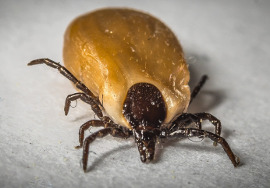 It’s that time of year again, tick season; the sun is out, the snow is melting, and with that the ticks are repopulating.
It’s that time of year again, tick season; the sun is out, the snow is melting, and with that the ticks are repopulating.
In recent years, with the change in our global climate, mild weather days have been increasing. As a result, much of the tick population is surviving the winter permafrost rather than dying off each season. Tick numbers are growing exponentially every year, increasing risk to both people and animals.
Being informed and prepared early is essential to keeping your pet protected from potentially harmful parasites, and tick prevention is priority number one right now.
There are over 200 species of tick (Canada has about 40), and they can be found almost everywhere in the world.
Every tick – especially the black-legged tick – could transmit viruses, harmful bacteria, or even parasites. They spread a variety of illnesses, some of which can be transmitted on contact. This includes the well-known Lyme disease, but may also include a variety of other potentially deadly diseases. This is why being proactive this time of year is vital.
During winter months, ticks can be active in areas where there are frequent mild days with little snow, but the greatest risk is during the spring and summer, when tick populations are at their highest.
Here are the most effective ways to protect your pet from ticks this season:
1. Check your pets regularly. Give them a thorough check after every walk or trip outside – especially in forested areas and areas with tall grasses. Ticks can be extremely small, so be methodical when checking your pet. Pay particular attention to key areas such as the armpits, inside and around ears, in folds of skin, toes and pads, and in thick fur.
2. Stay away from high risk areas where tick populations are at their highest. This includes tall grass and low hanging branches, where ticks will sit in wait for a new host. Wooded and marshy areas, especially off-trail hiking spots, are the riskiest. Areas that are regularly maintained are lower risk, as it is more difficult for ticks to survive, however rogue ticks can be anywhere.
3. Try a preventative treatment. Commercial flea and tick treatments from a pet supply retailer are a reliable and low-maintenance method of tick prevention. Treatment applications are most commonly found in the form of shampoos, sprays, liquid spot-on, and oral tablets. Use caution when selecting the right option for your pet as many parasite products may contain potentially harmful ingredients.
Even if you take all these steps it is still possible to find a tick on a pet. If the tick has bitten your pet and has embedded itself in the skin, it’s important to use caution when removing it. You will need either a tick-removing tool or a pair of fine-point tweezers. Once you spread your pet’s fur, grasp the tick as close to the skin as possible. If you’re using tweezers, pull upwards gently and ensure you have removed the entire tick. Tick-removing tools usually employ a twisting motion to remove the tick. After removing the tick, treat the bite area and clean your removal tool with rubbing alcohol. Make sure to wash your hands.
Next, if you choose, collect the tick for testing. You may put a live tick in a jar with some alcohol to preserve it. Dead ticks can be wrapped in a folded paper towel or placed in a small plastic container. Contact your veterinarian about testing it for any tick-borne diseases.
Keeping pets safe from ticks can be simple and effective if you take the right precautions that are best suited for your pet.
Brandon Forder – also known as The Pet Expert – is vice-president of Canadian Pet Connection, a family-owned and -operated business located in Meaford. He has over twenty years experience specializing in pet nutrition, behaviour, and lifestyle. Canadian Pet Connection is an industry leader committed to providing their clients with the highest levels of personal, attentive service. Learn more at www.CanadianPetConnection.com.










